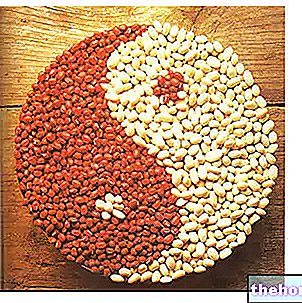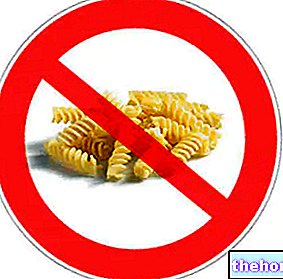
It should also be emphasized that, in the "field of fitness, aesthetic culture and well-being in general, the term" dietetic breakfast "can acquire a more vague and distorted meaning; in these fields, the term" dietetic "takes on a" generic and it is often understood as a synonym for: low calories, digestive ease and usefulness in "finding the line" (in great vogue after holidays or before summer).
We must not make the "mistake of misunderstanding the" diet meal "with a single" diet food "(as explained in the article:" Diet Snacks "); this clarification is essential to emphasize the "nutritional importance of breakfast, or the very first energy source of the day. A well-structured breakfast is NEVER composed of just one food (dietary or not) and provides" at least "the choice of 2 or 3 foods of a different nature; rather, therefore, it would be more suitable (or even advisable!) that the diet breakfast is composed of various "diet foods" (among which, for example, many products mentioned in the above article).
Now let's see in more detail how to formulate a good diet breakfast.
Note. Law No. 327 of March 29, 1951, EEC Directive 89/398 and Legislative Decree No. 111 of January 27, 1992 Diet food:product to which dietary properties are conferred and intended for a "diet for people who are in particular physiological or pathological conditions
. In general, the diseases that fall within the well-known Metabolic Syndrome (Dyslipidemia, Diabetes Mellitus type 2, Hypertension, Obesity, Visceral Accumulation, etc.) require a series of common dietary interventions, which can be summarized as follows:
- Reduction: calories, portions, glycemic load, glycemic index, total fat (especially saturated), alcohol and cholesterol. Elimination of added simple sugars and possibly also of added sodium. STOP to junk foods.
- Increase: of food water, fiber, the ratio between good fatty acids (especially omega 3) and bad ones (saturated and trans), and other useful molecules such as: phytosterols, lecithins, antioxidants, etc. GO FREE TO RAW FOODS , BUT ALWAYS IN RESPECT OF THE "NUTRITIONAL BALANCE!
Some examples of dietary breakfast against metabolic diseases are: milk fortified in omega 3 with All Brain, skim milk and fruit smoothie (blueberry, apple, kiwi), oat and wheat bran porridge with a few almonds and pine nuts, etc.
Obviously, even this kind of diet breakfast must take into account the subjective needs. We are not only talking about "tastes", but also about food intolerances. A person who is very lactose intolerant can benefit from replacing traditional milk with delactosed milk, while for those mildly sensitive it may be sufficient to resort to traditional yogurt, Greek or kefir. On the other hand, for celiacs the TOTAL exclusion of gluten is a FUNDAMENTAL requirement; in these cases, it is at least essential to discard both wheat and oats, possibly replaceable with: corn, rice, buckwheat, amaranth, etc.
and the line in general. Foods can be of a dietary type but, compared to the previous case, the need for nutritional balance is less urgent.
The diet breakfast for the line, intended as light weight loss and muscle definition for bodybuilders, must meet the following requirements:
- Blanda reduction: calories, portions, glycemic load, glycemic index, fats (if previously excessive) and simple added sugars (if previously excessive).
- Increase: in food water and fiber.
Some examples of dietetic breakfast for the line are: low-fat thickened yogurt with mixed cereal flakes, orange and grapefruit juice with raw ham toast, fruit salad and dry biscuits, light cottage cheese with wholemeal biscuits, semi-skimmed milk with bitter cocoa and aggregate cereals with dried fruit etc.
Also in this case, if you want to comply with the special needs of intolerant people, it is possible to replace the foods containing the prohibited molecule with other products of the same type but perfectly digestible / absorbable.
daily, avoiding excess (at the expense of the other two main meals) but also deficiency (creating a situation of early appetite). Obviously, this recommendation implies the need to know one's needs which also include the goal of the diet.To give a fairly simple example, assuming you have to calculate the energy intake of a diet breakfast for an obese subject with metabolic syndrome, who consumes about 1800kcal per day, the estimate should be performed as follows:
- Norm-calorie diet requirement: 1800kcal
- Objective: Weight loss and metabolic nutritional therapy
- Diet calories: 70% of the normocaloric = 1260kcal (HYPOCALORIC)
- Calories of the diet breakfast: 15% of the HYPOCALORIC = 189kcal
- Foods: 1 150g (81kcal) Natural Thickened Low-fat Yogurt, 2 tablespoons of Natural Wheat Bran (33kcal), 1 200g Granny Smith Apple (76kcal) = TOT 190kcal.
Note. In the case of the diet breakfast for the line it is advisable to provide about 90% of the normocaloric requirement and not 70%; the latter is in fact too scarce and, especially for those who practice physical activity, could reduce performance or (in the long term) compromise muscle trophism.




























